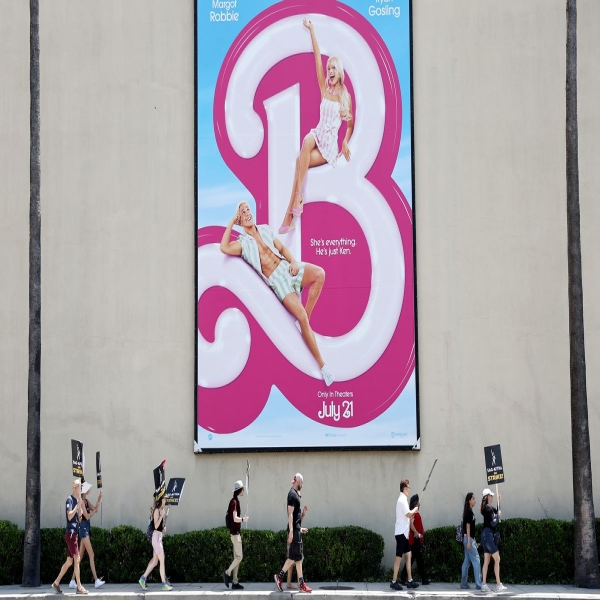CEOs like Bob Iger and David Zaslav seem willing to lose money during the writers and actors strikes. Why?

Emily Stewart covers business and economics for Vox and writes the newsletter The Big Squeeze, examining the ways ordinary people are being squeezed under capitalism. Before joining Vox, she worked for TheStreet.
A lot has been said, written, and chanted about what actors and writers in Hollywood want from their dual strikes currently underway, but what exactly is it that the studios and streamers want in all this? After all, they’re putting a lot of money on the line here. While in the short term, many of them are doing okay, in the long term, this could spell trouble for the very bottom lines they’re seeking to protect by playing such hardball in the first place.
The exception here is maybe Netflix, which benefits from having a slate of reality and foreign-made programming and viewers’ love of shows they’ve already watched a hundred times. But that will get old eventually, too, and Netflix’s viewers will need something fresh to chew on.
In case you have somehow missed it, Hollywood’s writers, represented by the Writers Guild of America (WGA), have been on strike since early May. They were joined by Hollywood’s actors, represented by the Screen Actors Guild and American Federation of Television and Radio Artists (SAG-AFTRA), in striking in mid-July. Both are locked in contract negotiations with the Alliance of Motion Picture and Television Producers (AMPTP), which represents Hollywood studios and production companies. Its members include Amazon, Apple, Disney, Warner Bros. Discovery, Netflix, NBCUniversal, among others. (Because it’s so difficult to know who owns what in media today, this little guide might be useful.)
Times have not been great for major media companies for a while now. Cord-cutting, meaning people axing their cable and satellite packages, has been a problem for years. The movies haven’t exactly been hitting home runs. And it turns out streaming — the thing that was supposed to replace all this and that the studios and tech companies have been dumping cash into — is hard to make money on.
The AMPTP argues that the asks the unions are making of its members are costs they simply cannot bear, given the current state of affairs. It’s a stance that is questionable, some observers say. WGA and SAG-AFTRA members argue that big media companies have no problem paying CEOs like Bob Iger and David Zaslav generously. The studios and tech companies are still making a lot of money, and they haven’t been particularly judicious on their spending as of late, said Michael Pachter, managing director at Wedbush Securities.
“This doesn’t cost them that much,” he said. “It’s one thing if they only made hits, to say, ‘We can’t afford a 5 percent cost increase or a 10 percent cost increase,’ but they make a lot of shit. Why don’t they just pay more attention and stop making shit?”
Some of the sticking points between the AMPTP and the WGA include the WGA’s demands on mandatory staffing and guarantees of employment, wage increases, and residuals for streaming. It doesn’t want quotas, and it doesn’t want to pay as much as writers are asking (you can see the AMPTP’s response to the WGA strike in May here).
There has recently been some movement between the parties. On Tuesday, August 22, the AMPTP released its latest proposal, including a minimum of 10 weeks of employment for writers in development rooms, a new structure to train writers to become showrunners, and a guarantee that writers’ compensation, credit, and rights won’t be affected by AI-produced material. The parties are also getting closer on pay. (Disclosure: Vox Media’s editorial team is unionized with the Writers Guild of America East. But its members are not part of the strike covered in this story, nor are they part of the contract negotiations with AMPTP.)
The WGA said the studios’ latest offer isn’t enough and “failed to sufficiently protect writers from the existential threats that caused us to strike in the first place.” Before the AMPTP released its proposal on Tuesday, executives and WGA leaders held a meeting that the WGA described as not a meeting to make a deal but instead a “meeting to get us to cave.” They’re back to picketing on Wednesday.
With SAG-AFTRA, the AMPTP says it’s given up ground in minimum increases, AI protections, and pension and health contribution caps, but it doesn’t want to give up more. The actors say they’re being stonewalled and that they are “fighting for the survival of our profession” on issues ranging from pay to AI.
In a statement to Vox, a spokesperson for the AMPTP said, “We remain committed to finding a path to mutually beneficial deals with both unions.”
Some of the studios are making money on the strike … for now
The most recent earnings season — when public companies have to tell investors what’s what every three months — has provided a picture of just how the big guys are handling the work stoppage.
Some companies have noted that the strikes have saved them some money because they’re not spending on production and making new things. Netflix said it expected its free cash flow to increase by $1.5 billion. Warner Bros. Discovery saved $100 million. Disney said it anticipated a $3 billion production cost cut.
That doesn’t mean the companies are thrilled about the situation. “This strike is not something that we wanted,” Netflix co-CEO Ted Sarandos said on the company’s second-quarter earnings call. “We make deals all the time. We are constantly at the table negotiating with writers, with directors, with actors and producers with everyone across the industry and we very much hoped to reach an agreement by now.”
“The short-term benefit is we did see in the second quarter a significant decline in terms of programming costs. Longer term, the question is really the effects to viewers, whether they be linear or streaming, of less new programming,” said Kenneth Leon, research director at CFRA Research. “Nobody really wins with these strikes.”
As the Hollywood Reporter notes, Lionsgate said it expects a $30 million revenue hit for the next quarter, and Warner Bros. Discovery adjusted its expectations lower because of a lack of content production and the TV ad market.
“Two things have happened — their pipeline starts to empty, but they’re essentially seeing better working capital,” said Neil Begley, an analyst at Moody’s. “It will help them, briefly, in trying to reduce debt and improve their credit metrics.”
Many companies, specifically on streaming, arrived at the strikes limping. They had been spending billions of dollars on content to try to get people to sign up for their respective, relatively low-cost streaming platforms (Peacock, Paramount+, Max, Disney+, etc., etc.).
Coming into this year, companies such as Disney and Warner Bros. Discovery said they were cutting spending on content, recognizing the bang they were getting in subscribers was not really worth the buck. Some streaming services are raising prices, too, to attempt to be more sustainable. As companies run out of content amid the strikes, they risk losing subscribers that are already hard to come by.
“Especially with the uptick in the cost of streaming these days, their price hikes, this is something which could start to lead to higher churn numbers,” said Jamie Lumley, an analyst at Third Bridge, an investment research firm. “Then some of those FAST [free, ad-supported, streaming television] options, like a Roku channel, a Freevee or a Tubi, they start to gain some appeal because they have content, which while not new could be new to viewers, and it’s also free.”
Some streamers have been dumping shows altogether in an effort to save money and tighten their belts.
The dominos are going to start to fall (in the fall)
The longer the strikes go on, the harder it gets for the big companies involved (and, of course, the striking writers and actors, as well as the knock-on effects for the rest of Hollywood, from makeup artists to local restaurants). Relatively short-term profitability boosts are a “tiny silver lining” in what will become an increasingly challenging scenario, said Lumley. “If there’s no new content, the age-old adage — content is king — still rings true.”
When the writers strike first set in this past spring, it was late-night variety and comedy shows like Saturday Night Live and The Late Show that were affected. Then summer came, when many shows were set to be on hiatus anyway and things typically slowed down.
Now, the fall is arriving, and many scripted TV shows that were supposed to go back on air are not going to appear. “For the Warner Bros. Discoveries, for the Paramounts, for the Comcasts with NBCUniversal, they’re already looking at their fall lineups, and basically what we’ve heard from our experts is that the fall is a wash,” Lumley said. They’ll have to put in more old content and lean in on unscripted TV. Sports will be a mitigating factor, though the audience for a scripted drama may not be the same as the audience for a football game.
The stunted fall TV season for companies will have downstream effects on their respective streaming services, which lean on their linear networks as pipelines, he added. What goes on CBS shows up on Paramount+; NBC series land on Peacock.
Fall movies are in a pickle, too — they may be finished and ready to ship, but because of the actors on strike, their stars aren’t going to be there to promote them. Movie studios were able to get summer mega-hits Barbie and Oppenheimer out with some cast promotions just in time, but there won’t be interviews or red carpets until the actors strike is over.
As the clock ticks, the situation for the studios and streamers gets more dire. Movie studios have already pushed back release dates and may continue to do so, and films that are still in production — now paused — will of course be delayed.
Netflix has some advantages, but even it won’t last forever
Streamers like Netflix and Apple have a cushion. They have some stuff in the pipeline — or a lot of stuff, in Netflix’s case — and viewers are used to waiting a long time in between seasons anyway. Even before the strikes, nobody knew when the next season of Apple TV+’s Severance or Hulu’s The Handmaid’s Tale were coming out.
For tech-first companies Amazon and Apple, this really won’t have a material impact on their overall businesses — they rake in plenty of money elsewhere. Still, it’s not ideal, Lumley said. Apple is new to the streaming space, so it doesn’t have a ton of content to fall back on. Amazon is in a better position, in part thanks to its 2022 acquisition of MGM, but its content library still isn’t enormous.
The player in all of this that has the most runway really is Netflix. About half of its total content catalog is old stuff, Pachter said, and of the other half, he estimates about 20 percent of it is domestically produced. “What they’ve done is they’ve leaned into Korean and dubbed stuff, so they’ll probably whittle down that 20 percent that’s US-produced to 15,” he said. “They’ll have a hole in their schedule, but we won’t notice.” (On Netflix, this includes shows like the Korean-made King the Land.)
Thanks to Netflix’s platform and content, it’s likely to endure longer than Paramount or Warner Bros. Discovery or even Disney. At some point, Netflix will also start to feel the pressure, too. “They have a little bit more runway for projects which are already completed, which are in post-production, and they can stretch out,” Lumley said. “And, they don’t have to worry about the drop in advertising dollars and potential ratings hit they might take for the fall.”
Wall Street is going to take notice as well. “The public equity market will begin to try to weigh how long the strikes will be and inevitably impact the share prices well before we see it in the actual results,” Leon said. “If they extend into 2024, that’s going to be a big problem.”
Leon added that smaller companies and financial investors in movie production are starting to get dragged in. “All of a sudden, when they’re looking at the return on their cost of money, it gets worse,” he said. “That’s another kind of factor that’s in play, where the financial investors in the entertainment industry want to get this done.”
There’s all sorts of collateral damage here. The Emmys have been postponed, and it’s not clear what will happen with the rest of awards season if the strikes drag on. Workers and businesses with various types of ancillary ties to TVs and movies are struggling amid the Hollywood stoppage.
It’s not clear who’s going to blink first — or what happens next
The AMPTP is back talking to the WGA; it’s not talking to SAG-AFTRA. Anyone who claims to know how and when the strikes will end is lying, and there’s a lot of uncertainty about what happens even when new contract deals are ultimately struck.
Again, the streaming boom is still over, and besides Netflix, nobody has really figured out a model to make it work.
Part of what’s being hammered out in strike negotiations is just exactly how residuals and royalties on streaming shows are supposed to work, which is representative of how the area is sort of a brave new world in a lot of ways in the entertainment industry.
“They’re part of why they are nervous around this, because these companies are looking at how to make just the business work in a sense that it’s sustainable while also figuring out how the talent, the creatives, the people involved in actually making the projects, how they can exist in this new world. Because in the olden days, royalties being a sustainable source of income … that has definitely changed,” Lumley said. “In streaming, there’s a lot less transparency around what exactly is a successful show, and how necessarily does that translate to remuneration for those involved in the project?”
To be sure, not everyone believes this is all that complicated. “Streaming has created a window that is uncompetitive, because the guys who produce in it are stupid, the bosses, and they’ve created this mess and they’re saying we’ll lose money on this stuff so we can’t afford to pay you residuals,” Pachter said. “That’s bullshit. Do it right, make money, and pay them what they’re due.”
Other preexisting problems, such as underperforming movies and perpetual cord-cutting, are going to persist as well. “The golden goose is getting old, and she’s not laying as many eggs, and you can see in a few years when all the sports move over to streaming as well, there could be a risk of a leg down in cord-cutting, which could accelerate the decay,” Begley said. If companies don’t have a strong streaming platform, which most don’t, they’re going to be in trouble.
There are all sorts of looming questions about what artificial intelligence will actually mean for television and movies (and all businesses, honestly), and whether and how companies will try to make up ground lost during the strikes. There could be a rush to pick up halted production, as there was after the pandemic, which would necessitate more workers — potentially more than there are available. Some projects might be tabled altogether.
The real takeaway here is every day, week, and month the strikes go on, the darker the landscape gets for everyone involved, including major corporations.
Source: vox.com






